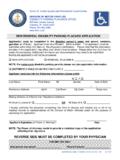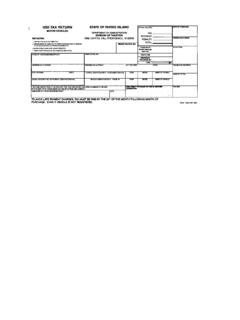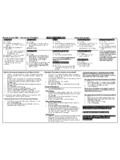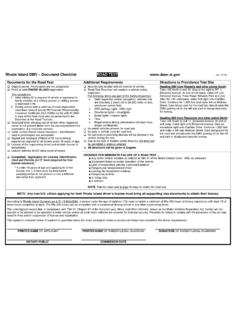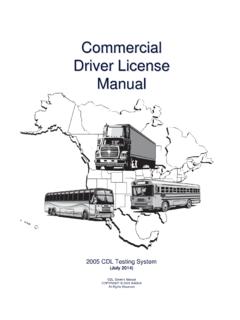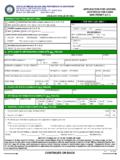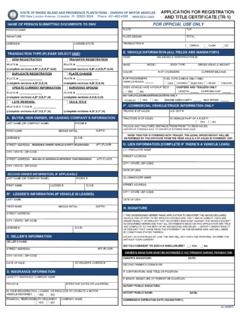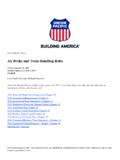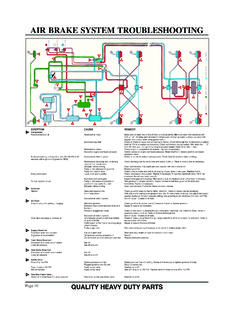Transcription of Section 5 Air Brakes - Rhode Island
1 2005 Commercial Driver's License Manual Air Compressor Governor Section 5. The governor controls when the air compressor will AIR Brakes pump air into the air storage tanks. When air tank pressure rises to the "cut-out" level (around 125. This Section Covers pounds per-square-inch or "psi"), the governor stops the compressor from pumping air. When the Air brake System Parts tank pressure falls to the "cut-in" pressure (around 100 psi), the governor allows the compressor to Dual Air brake Systems start pumping again. Inspecting Air Brakes Using Air Brakes Air Storage Tanks This Section tells you about air Brakes . If you want Air storage tanks are used to hold compressed air. to drive a truck or bus with air Brakes , or pull a The number and size of air tanks varies among trailer with air Brakes , you need to read this vehicles. The tanks will hold enough air to allow Section .
2 If you want to pull a trailer with air Brakes , the Brakes to be used several times, even if the you also need to read Section 6, Combination compressor stops working. Vehicles. An air brake endorsement is only required if your vehicle needs a CDL. Air Tank Drains Air Brakes use compressed air to make the Brakes Compressed air usually has some water and some work. Air Brakes are a good and safe way of compressor oil in it, which is bad for the air brake stopping large and heavy vehicles, but the Brakes system. For example, the water can freeze in cold must be well maintained and used properly. weather and cause brake failure. The water and oil tend to collect in the bottom of the air tank. Be sure Air Brakes are really three different braking that you drain the air tanks completely. Each air systems: service brake , parking brake , and tank is equipped with a drain valve in the bottom.
3 Emergency brake . There are two types: The service brake system applies and releases the Manually operated by turning a quarter turn or by Brakes when you use the brake pedal during pulling a cable. You must drain the tanks yourself normal driving. at the end of each day of driving. See Figure The parking brake system applies and releases the Automatic--the water and oil are automatically parking Brakes when you use the parking brake expelled. These tanks may be equipped for control. manual draining as well. The emergency brake system uses parts of the service and parking brake systems to stop the Automatic air tanks are available with electric vehicle in a brake system failure. heating devices. These help prevent freezing of the automatic drain in cold weather. The parts of these systems are discussed in greater detail below. The Parts of an Air brake System There are many parts to an air brake system.
4 You should know about the parts discussed here. Air Compressor The air compressor pumps air into the air storage tanks (reservoirs). The air compressor is connected to the engine through gears or a v-belt. The compressor may be air cooled or may be cooled by the engine cooling system. It may have Figure its own oil supply or be lubricated by engine oil. If the compressor has its own oil supply, check the oil level before driving. Section 5 Air Brakes Page 1. 2005 Commercial Driver's License Manual Alcohol Evaporator pushes the rod out, moving the slack adjuster, thus twisting the brake camshaft. This turns the s-cam Some air brake systems have an alcohol (so called because it is shaped like the letter "S"). evaporator to put alcohol into the air system. This The s-cam forces the brake shoes away from one helps to reduce the risk of ice in air brake valves another and presses them against the inside of the and other parts during cold weather.
5 Ice inside the brake drum. When you release the brake pedal, system can make the Brakes stop working. the s-cam rotates back and a spring pulls the brake shoes away from the drum, letting the wheels roll Check the alcohol container and fill up as freely again. See Figure necessary, every day during cold weather. Daily air tank drainage is still needed to get rid of water and oil. (Unless the system has automatic drain valves.). Safety Valve A safety relief valve is installed in the first tank the air compressor pumps air to. The safety valve protects the tank and the rest of the system from too much pressure. The valve is usually set to open at 150 psi. If the safety valve releases air, something is wrong. Have the fault fixed by a mechanic. The brake Pedal You put on the Brakes by pushing down the brake pedal. (It is also called the foot valve or treadle valve.)
6 Pushing the pedal down harder applies Figure more air pressure. Letting up on the brake pedal reduces the air pressure and releases the Brakes . Wedge Brakes . In this type of brake , the brake Releasing the Brakes lets some compressed air go chamber push rod pushes a wedge directly out of the system, so the air pressure in the tanks between the ends of two brake shoes. This shoves is reduced. It must be made up by the air them apart and against the inside of the brake compressor. Pressing and releasing the pedal drum. Wedge Brakes may have a single brake unnecessarily can let air out faster than the chamber, or two brake chambers, pushing wedges compressor can replace it. If the pressure gets too in at both ends of the brake shoes. Wedge type low, the Brakes won't work. Brakes may be self-adjusting or may require manual adjustment. Foundation Brakes Disc Brakes .
7 In air-operated disc Brakes , air Foundation Brakes are used at each wheel. The pressure acts on a brake chamber and slack adjuster, like s-cam Brakes . But instead of the s- most common type is the s-cam drum brake . The cam, a "power screw" is used. The pressure of the parts of the brake are discussed below. brake chamber on the slack adjuster turns the power screw. The power screw clamps the disc or brake Drums, Shoes, and Linings. brake drums rotor between the brake lining pads of a caliper, are located on each end of the vehicle's axles. The wheels are bolted to the drums. The braking similar to a large c-clamp. mechanism is inside the drum. To stop, the brake Wedge Brakes and disc Brakes are less common shoes and linings are pushed against the inside of the drum. This causes friction, which slows the than s-cam Brakes . vehicle (and creates heat).
8 The heat a drum can take without damage depends on how hard and Supply Pressure Gauges how long the Brakes are used. Too much heat can make the Brakes stop working. All vehicles with air Brakes have a pressure gauge connected to the air tank. If the vehicle has a dual S-cam Brakes . When you push the brake pedal, air brake system, there will be a gauge for each air is let into each brake chamber. Air pressure half of the system. (Or a single gauge with two Section 5 Air Brakes Page 2. 2005 Commercial Driver's License Manual needles.) Dual systems will be discussed later. all conditions. Tests have shown front wheel skids These gauges tell you how much pressure is in the from braking are not likely even on ice. Make sure air tanks. the control is in the "normal" position to have normal stopping power. Application Pressure Gauge Many vehicles have automatic front wheel limiting This gauge shows how much air pressure you are valves.
9 They reduce the air to the front Brakes applying to the Brakes . (This gauge is not on all except when the Brakes are put on very hard (60. vehicles.) Increasing application pressure to hold psi or more application pressure). These valves the same speed means the Brakes are fading. You cannot be controlled by the driver. should slow down and use a lower gear. The need for increased pressure can also be caused by Spring Brakes Brakes out of adjustment, air leaks, or mechanical problems. All trucks, truck tractors, and buses must be equipped with emergency Brakes and parking Low Air Pressure Warning Brakes . They must be held on by mechanical force (because air pressure can eventually leak away). A low air pressure warning signal is required on Spring Brakes are usually used to meet these vehicles with air Brakes . A warning signal you can needs.
10 When driving, powerful springs are held see must come on before the air pressure in the back by air pressure. If the air pressure is tanks falls below 60 psi. (Or one half the removed, the springs put on the Brakes . A parking compressor governor cutout pressure on older brake control in the cab allows the driver to let the vehicles.) The warning is usually a red light. A air out of the spring Brakes . This lets the springs buzzer may also come on. put the Brakes on. A leak in the air brake system, which causes all the air to be lost, will also cause Another type of warning is the "wig wag." This the springs to put on the Brakes . device drops a mechanical arm into your view when the pressure in the system drops below 60 Tractor and straight truck spring Brakes will come psi. An automatic wig wag will rise out of your view fully on when air pressure drops to a range of 20 to when the pressure in the system goes above 60 45 psi (typically 20 to 30 psi).
